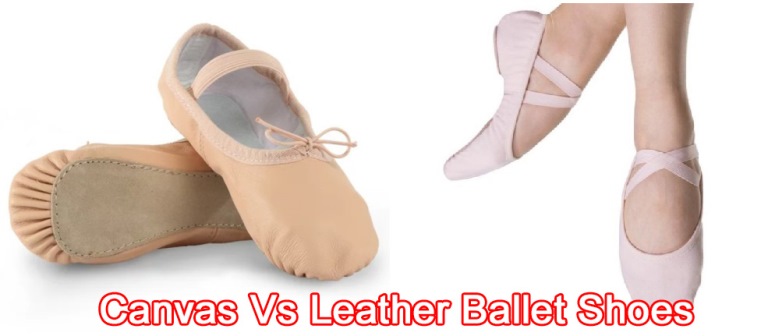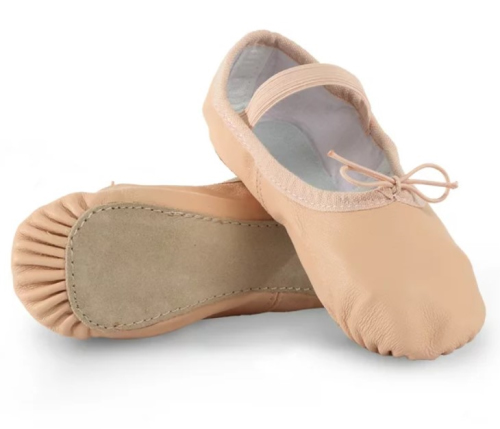When you first get into ballet, there might not be any difference between canvas ballet shoes vs leather shoes. But an intricate art such as ballet has more to talk about beneath the beautiful facade.
Finding the right shoes gives you the momentum to perfect your moves and pursue your passion.
Table of Contents
Why Canvas & Leather Shoes Are Popular In Ballet?
Ballet shoes, or pointe shoes, are the soul of ballet.
They are specifically for pointe work, where the dancer stands on the tip of their toes and holds their posture in a graceful line that makes them look weightless.
Gone were the days when ballet shoes had heels or features of slippers, Anna Pavlova was perhaps the first ballerina to use modern pointe shoes.
Pavlova’s feet anatomy was prone to injuries. And, she had to decrease the risk with tough leather soles and a hardened toe box.
Canvas is the most popular material among ballet shoes due to the reasonable price and durability that beginners look for. It is preferred by male dancers since they can handle the extra weight.
With a bigger price tag, leather has more advantages over canvas.
Although it takes a while to stretch and accommodate your feet, the fit is nonpareil, and the lifespan is for sure longer. Besides the cost, maintenance is also a challenge for new users.
Last but not least, satin ballet shoes are the go-to option if you are looking for something aesthetic.
The biggest setback of satin shoes is they are not for heavy duties. In most cases, we recommend keeping them for performances and other special occasions.
Check more: What Is A Tutu? Different Types Of Tutu Dress
Canvas Ballet Shoes vs Leather: Key Differences
The key difference between Canvas and leather ballet shoes lies in the sole.
You will usually find canvas shoes with split shoes only, while leather shoes have both split soles and full soles.
Furthermore, the textures of these materials are also drastically different from each other. Thus, we can tell from merely touching them.
Development In Strength
It is still a matter of experience.
But people claim that full-sole leather shoes can help young dancers develop an awareness of kinaesthetic, for they would feel like they are trying to overcome something more than bare feet.
With the jumping and sliding movements, the strength of your feet will certainly improve, even more so with a proper pair of shoes.
With thinner fibers and split soles, canvas shoes might not excel in this aspect.
Slip Balance
Leather has a stronger grip on wooden floors, which tend to have slippery or dusty issues.
But when it comes to a Tarkett or linoleum surface, this grip might be too much and gradually convince the dancer to rely on it rather than training their rotator muscle.
On the other hand, canvas is naturally more slippery than leather. Hence, the dancer might have to exert to maintain their balance while moving around.
Canvas vs Leather Durability
Without a doubt, leather is a very durable material for making clothes and footwear. Meanwhile, the canvas is more acclaimed for being lightweight and affordable.
Leather also needs a break-in period before you can fully enjoy the luxury comfort.
However, we need to acknowledge modern technologies and the changes they have brought.
Canvas nowadays is not a cheap and fragile material anymore. Usually, the young dancers will grow out of their canvas shoes first before they wear out and break down.
Price
Items made of canvas are more affordable than leather with almost no exception. As a less costly choice, canvas doesn’t require too much effort in maintenance.
In turn, leather is not the most compatible choice if you have a limited budget. But the “you get what you pay for” principle has never been more right in this case.
Canvas Ballet Shoes Pros & Cons
Pros
- Canvas is pretty easy to clean. You can use the washing machine or wash it by hand.
- It is not as expensive as leather. And, the amendment for canvas is less complicated as well.
- Both double and single elastics are available.
- Your footwork will have more spotlight with canvas because it is much thinner than leather.
Cons
- It is not as durable as leather. Hence, you might need to replace it sooner than expected.
- Canvas ballet shoes are usually split-sole only.
- Hardwood floors feel a bit slippery for canvas shoes.
Leather Ballet Shoes Pros & Cons
Pros
- Leather is the most durable material for ballet footwear.
- It molds to the feet and provides the most support.
- Full-sole and split-sole are both available.
- You can use paints or polishes to restore color and shine.
Cons
- Some surfaces make leather shoes feel sticky.
- Mending and cleaning are not simple tasks with leather. They usually require some experience.
- Leather belongs to the expensive side of materials.
Check more: 7 Best Shoes For Zumba Dance Classes
FAQs
1. How Long Do Canvas Ballet Shoes Last?
Depending on how much and how hard you dance, canvas shoes can stay with you for a while or leave you early.
Professional dancers tend to replace them every 30 days, while novices might keep them for a few months.
Replacing worn-out canvas shoes is important, for deteriorating canvas will be the perfect condition for bacteria and moisture to build up.
Aside from bad odors, ballet shoes with holes growing won’t give you the support and comfort you need.
We agree that washing will help you get rid of the dirt and the smell, but canvas can’t endure such treatments.
2. How Long Do Leather Ballet Slippers Last?
Leather is one of the best materials in terms of comfort as well as durability. Hence, your leather ballet slippers can sustain for 2 – 3 months at least.
However, there are still tips for you to take care of and make the most out of them.
- Don’t throw your leather slippers into the washing machine. If you, unfortunately, get some stains on your shoes, you can use baby wipes and a damp cloth to remove the spots first.
- Mild detergents are for more thorough cleaning but remember to test first, in case the chemical is not compatible with leather.
- When you feel like the shoes are losing their grip yet you find no problem on the outside, you can roughen the soles again with a clean brush.
- Regularly restore the shine of leather with Vaseliine or polish. Make sure the polish matches the color of your shoes!
- After cleaning and treating them, let them dry and air naturally.
3. What Are The Best Pointe Shoes For Beginners?
Getting to en pointe is an achievement for every ballet dancer, and demi-pointe shoes assure a smooth beginning.
The softer box in demi-pointe shoes is not as harsh on your feet as proper pointe shoes. Hence, you can gradually familiarize yourself with the challenge of standing on your toes.
Nonetheless, you should also keep in mind that the demi-pointe shoes don’t have much support either. It’s why they are only acceptable during training periods.
Another dilemma for new dance parents: should they choose canvas or leather ballet shoes for toddlers?
The best choice for the baby would be leather shoes with drawstrings to adjust the fit and full soles.
4. Should Ballet Shoes Be Tight?
The right ballet shoes should hug your feet snugly like the socks usually do. If you can’t keep your feet flat on the ground, your shoes might be too tight.
On the other hand, the shoes will be too loose if you find excessive fabric on your heels or toes. Adjusting half a size is enough to solve your problem.
So, Are Canvas Ballet Shoes Better Than Leather?
When choosing your first ballet shoes, canvas vs leather shoes might be a tough question to answer.
If we are talking about quality and durability, leather would always win by a landslide. Meanwhile, people who are only trying ballet out as a side hobby will find the price and the low maintenance of canvas more beneficial.
Canvas is not necessarily better than leather, though it certainly targets a larger group of customers.


